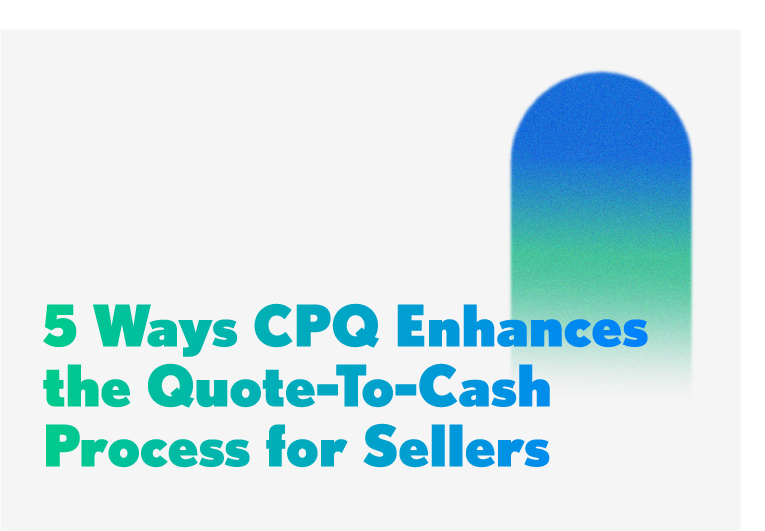We all know the saying “time is money.” As cliche as the adage may have become in certain settings, it still holds true when it comes to the success of your quote-to-cash process. The technology you provide to your customers should be strong enough to end on a high note – not just start on one.
If a shopper is at the point where they’re ready to submit an order for purchase, the absolute last thing they want to come up against is a lengthy, drawn-out closing process. Often, quoting or fulfillment delays can be traced back to incongruencies between your configure, price, quote and enterprise resource planning solutions.
CPQ software is designed to provide support throughout the buying process, from configuration through the generation of a final quote and bill of materials. From that point, ERP tools pick up the order and help to manage physical fulfillment, shipping, and bookkeeping aspects.
Together, CPQ and ERP solutions span the entirety of the quote-to-cash process, and should work in close tandem to create a frictionless experience.
Information should successfully flow from the top of the pipeline down, through CPQ and into ERP and back again as needed, but a lot can get lost between the cracks if there isn’t a well-structured bridge between the two systems. That’s where system integration – particularly the kind augmented by our world-class commerce logic engine – comes into play.
If you find yourself struggling under the weight of a subpar legacy configurator, there’s never been a better time to consider making a switch. Logik.io’s Lightspeed Migration Program can get you into a brand new tech stack in just a matter of weeks. Learn more via our free handbook, downloadable here.
Taking the time to properly integrate your CPQ and ERP solutions can streamline your overall QTC pipeline by reducing processing delays, unifying data within a larger ecosystem, and delivering the right BOMs to the right places.
Reducing Processing Delays
The closer together your CPQ and ERP solutions are architected, the easier it is to transmit data between the two. Integrating your tools allows for custom triggers to deploy across a centralized tech stack, kickstarting QTC processes on either side of the equation in unison.
A single point of input, like the “click to submit” button on the front-end, can create a ripple effect that presents order data in one manner to the buyer, and in another to the back-end.
The fewer triggers needed to complete a sales cycle, the faster a buyer sees their quote-to-cash process result in a successful order.
Filtering information from a unified source of truth created by CPQ and ERP integration also prevents possible silos created by disparate systems and reduces the amount of time the system needs to fill in necessary data points.
The more your CPQ and ERP solutions can directly communicate, the less manual effort is needed on the part of sales reps or order fulfillment specialists throughout the workflow. And as more of the process becomes automated and aligned, there too comes a narrower margin of human error that could delay the final order.
Unifying Under Salesforce
A recent study proctored by Logik.io showed that 95.9% of system integration partners are experiencing an increased interest in consolidating to a Salesforce-centric ecosystem.
The scaffolding provided within the cloud ecosystem allows for enhanced communication between Salesforce CPQ and both ERP and MRP systems. No stranger to the scene, our commerce logic engine was built natively to the Salesforce platform, though our headless architecture allows us to integrate widely.
SI partners aren’t the only ones with their eye on Salesforce. We’ve taken a deep dive into all the ways a Salesforce-centric ecosystem supports sophisticated selling practices. Discover the architectural benefits and more here
With Logik.io, Salesforce CPQ provides a seamless handoff to your ERP, via a separate object that makes it easy to extract manufacturing and finance inputs.
Proprietary features like our Solving Engine 2.0, message flexibility, and data reusability via “Sets” further enhance the customer experience and guide shoppers toward the most optimized carts.
Best Utilizing BOM Differentiation
Not all BOMs are created equal, and advanced commerce engines like Logik.io can help generate sales BOMs, manufacturing BOMs, hierarchical BOMs, and more in concurrence with one another.
How does this variety of bills help strengthen the CPQ-ERP connection?
It delivers the most relevant, precise information to a specific audience at the exact right point in the pipeline, and doesn’t necessitate multiple spins of the same data set to do so.
This segmentation helps keep clear lines of distinction between the roles of buyers and producers in the back-end setting, allowing both CPQ and ERP tools to focus specifically on the task at hand.
Manufacturing lines don’t need the receipt-style sales BOMs that customers do, and similarly can customers do without the line-item heavy manufacturing BOMs required to fabricate the pieces of their order.
You may even want to create a hierarchical BOM for the consumer, which more visually outlines the components of an order as opposed to line-item, or “flat,” stylized BOMs. With no two buyers having the same needs, expanding the options with which they can engage increases the chance of them clicking with the experience and following it through to the end.
If they can clearly see and understand what they’re ordering, they’ll come through the pipeline with more confidence and fewer instances of returns or cancellations.
It’s clear that constructing a tech stack which properly integrates CPQ and ERP solutions benefits the overall quote-to-cash process in more ways than one. The question remains: is your integration where you want it to be?
If not, Logik.io is happy to help. Feel free to peruse more of our use case resources, explore a guided demo of our premiere commerce logic engine and its offerings, or schedule a time to chat with one of our in-house experts.


